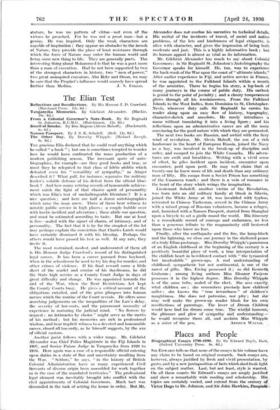Places and People
Biographical Essays 1790-1890. By Sir Edward Boyle, Bart. (Oxford University Press. 8s. tid.) Ste EDWARD tells us that none of the essays in his volume have any claim to be based on original research. Such essays are, however, always justified by fresh and vivid presentation, by
gusto, and bya new juxtaposition of facts which shed fresh light on the subject matter. Last, but not least, style is wanted.
Op all these counts Sir Edward's essays are amply justified and show a remarkably wide reading and scholarship. His _ topics are certainly varied, and extend from the oratory of Victor Jiugo to Dr. Johnson, and Sir John Hawkins, ..Pasquale-
Paoli, Byron's funeral, Samuel Rogers, the Banker Poet, Harriet Martineau, Christina Rossetti, and the Italienische Reise of Goethe.
The essay on Rogers is typical of the rest and gives a remark- ably vivid picture of the old gentleman whose life spanned so many periods and careers. Rogers' taste in art and literature did not extend to music for
"although he delighted hi sweet sounds, in soft-flowing harmonies, he had slight relish for the acknowledged masterpieces of Handel, Beethoven, or Mozart.' When he dined at home and alone, it was his custom to have an Italian organ-grinder playing in the hall, the organ being set to the Sicilian Mariners' air and other popular tunes of the South."
Sir Edward is a member of the Athenaeum, and therefore probably acquainted with the old legend that Rogers in his
old age was constantly accosted by women of the town as he left the Club and never presented any of them with less than one shilling. This was, of course, not far from the days of the night-watchman and of the reference in The Times to the " unwashed literati of the Athenaeum."
Seventy-three pages of the book are devoted to Château- briand and Le Genie du Chrisliauis-me. Those who have never been able to wade through Chateaubriand will here find a very handy guide to a book which in its time made a great impres- sion and inspired many succeeding French writers, a list of whom is given at the end of the essay. Sir Edward's criticism is constructive, but also impartial. The account of Château- briand's death and burial shows Sir Edward's style at its best.
"The end came on July 4th, 1848, the day of the Revolution, and the gun sounded in his cars as he died. To some men their tomb is a matter of indifference, to Chateaubriani it was, on the contrary, a matter which had exercised his mind for years. He is buried on a rock in the open sea off his native St. Malo. The rock, the Grand Be, is approachable only at low water, and on its seaward side there is the grave, visible from the ramparts, a stone and cross which boar no name. No more romantic spot can be imagined ; the picturesque town with its inediaeval walls and its little tidal harbour, the broken, bare, hilly coastline extending on either side as far as the eye can see. Such a tomb suggests pride and, at the same time, humility, loneliness, and romance. Silhouetted against the sky-line it is a constant witness to the thesis which Le Genie was written to prove. It is, in fact, an epitome of Chateaubriand."
It seems a pity that there should be no index to a book dealing with such varied subject matter.
E. S. P. HAYNES.



















































 Previous page
Previous page